Viacheslav Abukhba: Abkhazian philately: burnt rarities and American fakes

Postage-stamps of Abkhazia were issued for twenty years from 1993 to 2013, but after the fire at the Sukhum post-office their entire collection was lost.
As to how Eduard Pilia created the postal service of independent Abkhazia and American companies produced fake stamps, Konstantin Pilia, son of the general director of Abkhazsvjaz [‘Abkhazian Link’], and collector Viacheslav Abukhba explained to Sputnik correspondent Vladimir Begunov.
Eduard Pilia - man and the state-owned company
“The last thing that my father released,” says Konstantin Pilia, “was in 2013, a jubilee-envelope dedicated to the twentieth anniversary of the independence of Abkhazia. But a year before that there was a fire when the Sukhum post-office with all the archives was burned down. There they had a complete collection of stamps issued from 1993, which now, probably, no one possesses. My father kept everything at work, whilst only a catalogue and separate copies of stamps remained at home. ”
According to Konstantin Pilia, who himself was the head of the Sukhum post-office, at present, Abkhazia does not use its own designs for postal payment.
“Now Abkhazia works through the ‘Postal Service of Russia’. We affix Russian postage stamps, deliver correspondence to Adler, and from there it is sent to the addressee,” says Konstantin Pilia.
The story of the post in Abkhazia began in 1993.
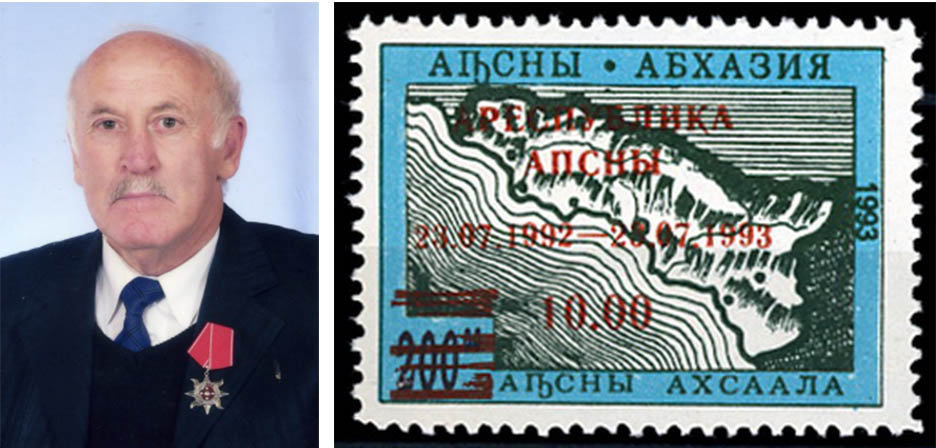
Eduard Pilia and the first stamp of Independent Abkhazia (1993).
“My father spent forty years at the post-office in Gudauta. After the victory of Abkhazia in the war of independence, he became the Minister of Communications, and then founded the state-owned company Abkhazsvyaz ‘Abkhazian Link’, which produced Abkhazian postage stamps and commemorative envelopes. But of the state-owned company there was only a name and status, yet it rested only on my father and on his connections,” says Konstantin Piliia.
Rare Citrus-harvest
According to Konstantin, Eduard Pilia would send technical instruction on the thematic series and individual stamps to one of the Moscow printing-houses with which he worked. There, based on his data and wishes, drawings were created, stamps were printed and sent to Abkhazia. Here they were distributed through the post-offices, and the work of the artist and the printing-house was paid for from the proceeds.
According to data that can be found in the public domain, Abkhazia had no presence in the philately of tsarist Russia; at that time there were in practice no thematic stamps, the emblem of the Russian Empire or portraits of emperors only being depicted on postage stamps. But in Soviet times in 1947, a series of three designs with views of Gagra, New Athos and Sukhum came out.
Three years later, a rare Soviet stamp appeared which depicted a collection of citrus fruits with the inscription: “We will give the country more lemons, oranges and tangerines!”. In 1959, another stamp with an Abkhazian theme was issued – a view over Lake Ritsa. Abkhazia was becoming a resort of all-Union significance, and this had to be reflected in philately. And that, in fact, was all there was.
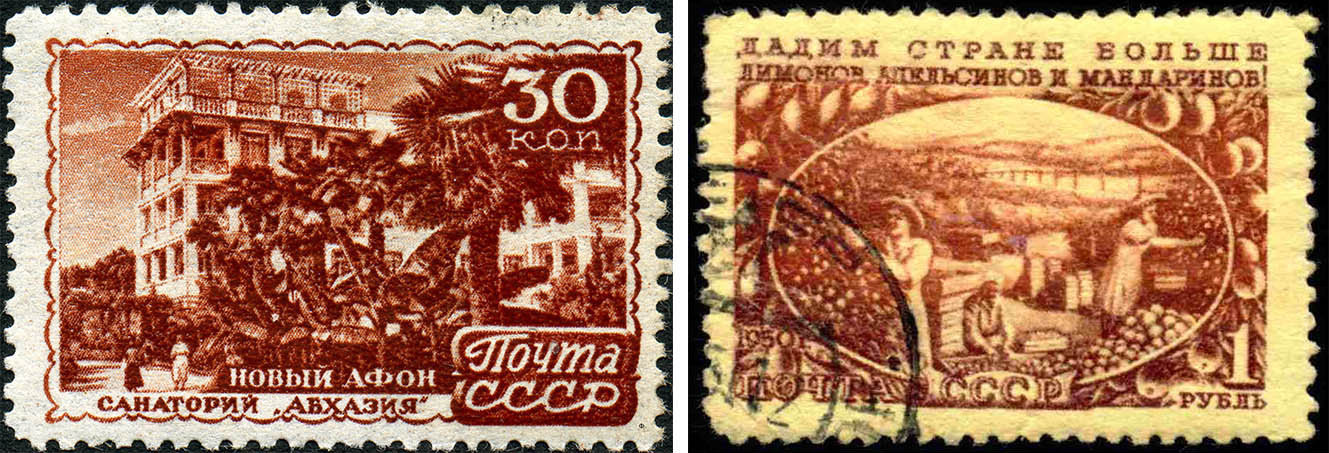
Soviet stamps dedicated to Abkhazia (1947 and 1950).
The fully-fledged history of Abkhazian postage-stamps begins exactly with Eduard Pilia.
As Konstantin Pilia recalls, the Russian community was helping Abkhazia, which found itself blockaded in the mid-1990s, in terms of postal communication by even transporting across the border the correspondence of the unrecognised republic, thereby helping to maintain contact with the world. Letters travelling into Abkhazia were mostly brought by the Red Cross mission.
Abkhazian stamps were allowed only for sending letters within the republic.
+ Postage stamps of the Republic of Abkhazia Catalog 1993-2003 (Sukhum 2004)
In total, Eduard Pilia issued more than two hundred different postage-stamps. There were series dedicated to famous native citizens of Abkhazia, Russian writers associated with the republic, nature, flora and fauna, ancient coins, football and even European painting.
Fake “Abkhazian” John Lennon
Things proceeded not without oddities. The most famous are fake Abkhazian stamps issued in the USA. In 1992, an American company signed a postage-stamp contract with Abkhazia. Conditions turned out to be one-sided, the Americans themselves determining the topic, controlling the implementation, and keeping half the print-run. We withdrew from their services, but our unconstituted partners issued three fake stamps. They even look very strange in appearance, for these are Russian stamps on top of which is imprinted the outline of the map of Abkhazia, painted in the colours of the national flag.
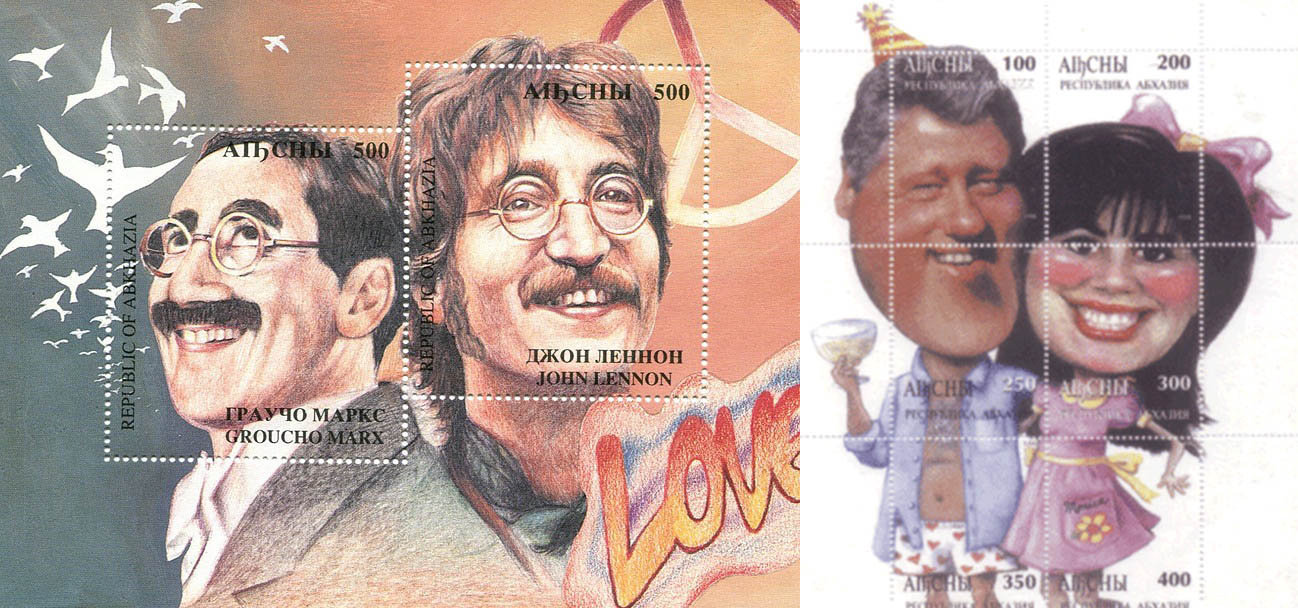
Fake stamps issued in the USA under the guise of Abkhazia in 1995.
Another postal oddity related to Abkhazia hit the pages of the New York Times in 1995. Another American company presented to the philatelic community an allegedly genuine Abkhazian postal block (a paper sheet that can be of different sizes, with one or more stamps that are part of the overall composition - ed.). This depicted actor Groucho Marx and the Beatle John Lennon. It was a play on the similarity of the surnames — Marx and Lenin. No one took the joke seriously, especially since this company was notorious for similar falsifications. In the same year, it was sued over the illegal issue of stamps of the Republic of Chad about the Beatles group.
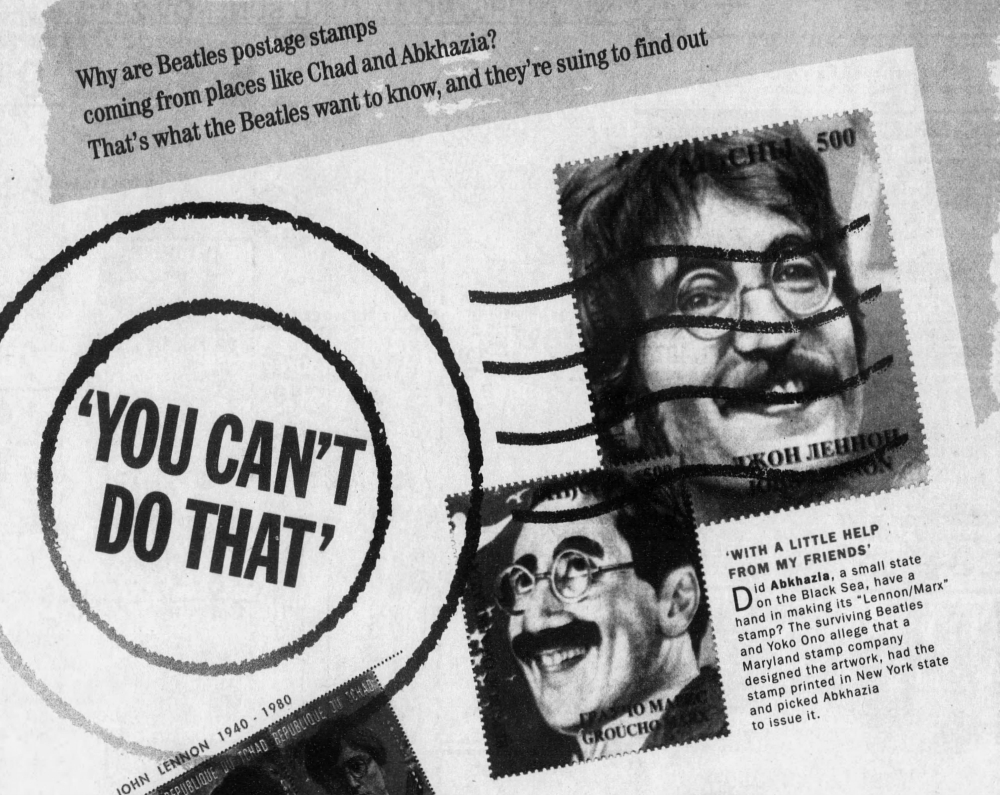
Chicago Tribune - 19 November 1996
“There was another fake stamp with the image of Bill Clinton and Monica Lewinsky, which, unfortunately, I don’t have,” says Vjacheslav Abukhba, head doctor of Sukhum City Clinical Hospital. Vjacheslav Firatovich [sc. Abukhba -- ed.] is Abkhazia’s greatest stamp-collector; he has amassed an almost complete collection of Abkhazian stamps. According to him, he has been fond of philately since school. He started by collecting stamps of the British Empire, and then, when Eduard Pilia began to produce Abkhazian stamps, he switched to them.
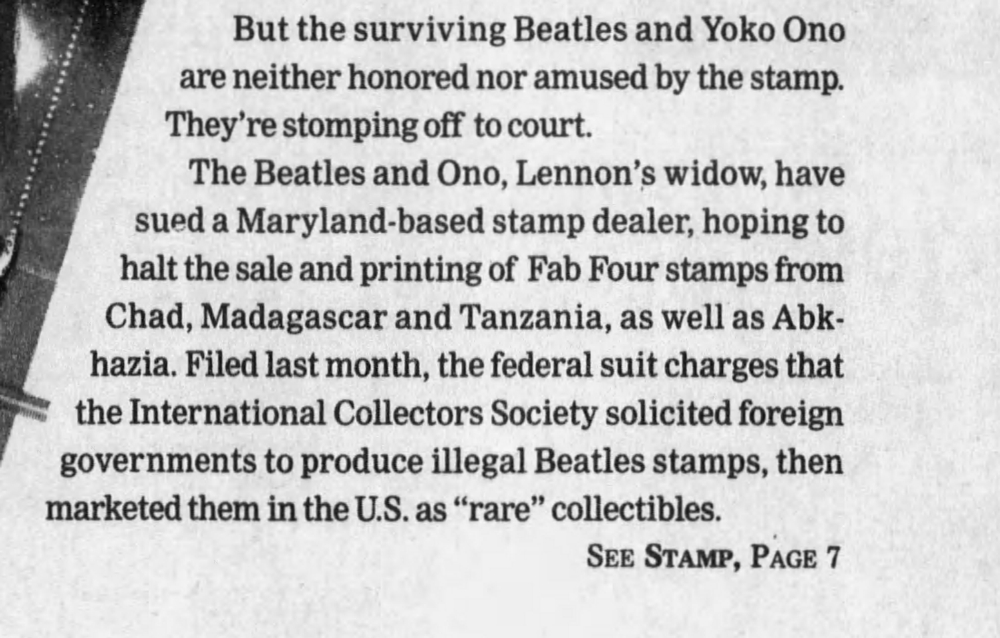
Chicago Tribune - 19 November 1996
Unrealised Symbol for ConIFA
“Issuing postage-stamps in Abkhazia is a wise decision,” says Vjacheslav Abukhba. “In the world, the brands of small, unrecognised countries that are difficult to obtain are highly valued. And Eduard Pilia produced many diverse and interesting series with historical figures, heroes of Abkhazia. Rare and interesting stamps are those with portraits of Abkhazian centenarians. By the way, on two stamps there are images of my grandfather Dzhato Abukhba, partisan of Belarus, and my father, the famous lawyer Firat Abukhba. ”
According to Viacheslav Abukhba, he turned to the Football Federation of Abkhazia with a proposal to issue stamps for the ConIFA World Cup.
“Many countries have produced such brands for various sporting events,” says the collector. “People often do not understand that postage-stamps are a historical document. In the face of them, borders and time are powerless. In addition, they raise the profile of the country. For example, we know little about the island of Mauritius, except that the rarest and most expensive postage-stamps in history were issued there. Special stamps for the ConIFA championship could have become one of its symbols for which collectors from different countries would have hunted years later."

Stamps of different countries for football-competitions, among them there could have been Abkhazian stamps for the ConIFA Championship.
Konstantin Pilia said that after the death of his father, people came to him who would like to continue his work, but so far everything remains just at the level of talk. And no-one has such connections in the postal and publishing circles as the founder of the Abkhaz philately Eduard Pilia had. No Abkhazian postage stamps have been issued over the past three years.
This article was published by Sputnik Abkhazia and is translated from Russian.